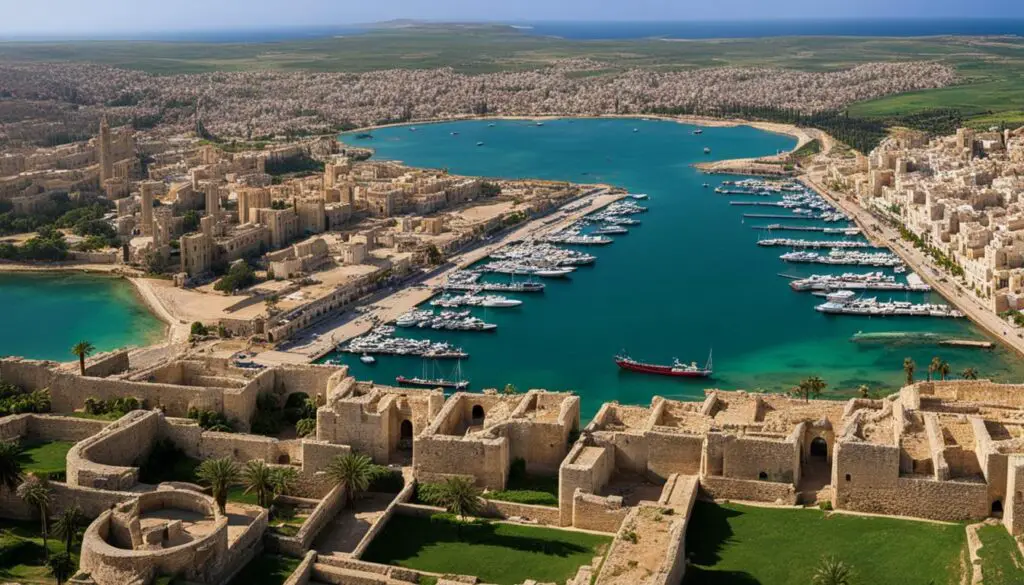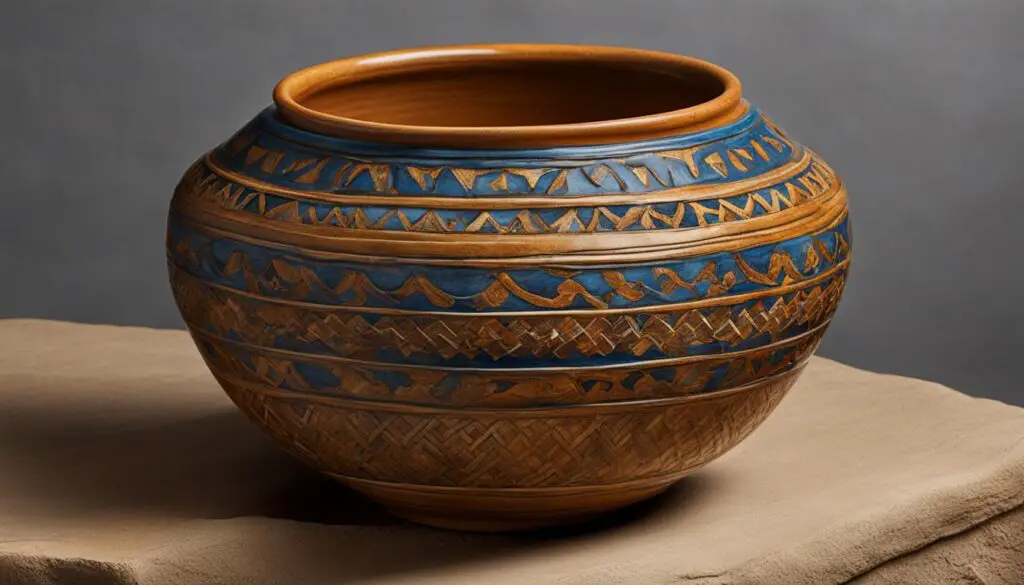Phoenicia, an ancient region along the eastern coast of the Mediterranean, is a treasure trove of history and culture. Inhabited by the Phoenicians, renowned merchants, traders, and colonizers, Phoenicia flourished during the 1st millennium BCE. The major cities of Byblos, Sidon, Tyre, and Beirut were bustling centers of trade and commerce, establishing colonies and trade routes that spread their influence far and wide. Today, Phoenicia offers a fascinating glimpse into its ancient past and the biblical significance that shaped its history.
Key Takeaways:
- Phoenicia was an ancient region along the eastern coast of the Mediterranean.
- The Phoenicians were renowned merchants, traders, and colonizers.
- Major cities like Byblos, Sidon, Tyre, and Beirut played a pivotal role in trade and commerce.
- Phoenicia holds great biblical importance, with notable figures and events linked to the region.
- Phoenicia’s rich history can be explored and appreciated today.
Biblical Significance of Phoenicia
Phoenicia holds great biblical importance. It is mentioned in various texts, including the Amarna Letters and the Bible. The region’s biblical significance is attributed to several notable figures and events.
Among the biblical figures linked to Phoenicia, Severus Alexander, a Roman Emperor of Phoenician descent, stands out. His reign marked a significant period in Phoenician history, as he played a crucial role in promoting the influence and prosperity of the region. Another notable figure is Ulpian, a renowned jurist, who was born in Tyre, one of the major cities of Phoenicia.
Phoenicia was also the setting for several major biblical events. One such event is the visit of the Prophet Elijah to Sarepta, a Phoenician city. This encounter played a significant role in the religious narratives of the time and contributed to the cultural legacy of Phoenicia.
“Phoenicia, with its rich history intertwined with biblical figures and events, continues to fascinate historians and scholars alike.”
The biblical importance of Phoenicia serves as a testament to the enduring legacy and cultural significance of this ancient civilization. Its connection to notable figures and events further underscores the impact Phoenicia had on the historical and religious landscape of the region.
Phoenician Civilization in Biblical Times
In biblical times, Phoenicia was a region characterized by its city-states, each with its own king. These cities, such as Byblos, Tyre, and Sidon, played a vital role in the trade and commerce of the ancient world. Phoenicia’s kingship system allowed for both local autonomy and a centralized authority, ensuring the smooth functioning of trade networks and cultural exchanges.
Throughout its history, Phoenicia experienced various periods of domination by foreign powers. During the biblical era, Assyria ruled over Phoenicia for a time, followed by the Achaemenid Persians and later the Romans. Despite these changes in rulership, Phoenician cities continued to thrive as key trading hubs, facilitating the exchange of goods and ideas between different civilizations.
The Phoenicians’ trade networks stretched far and wide, connecting Phoenicia to other regions of the Mediterranean and beyond. Their ships navigated trade routes that reached the Greek islands, southern Europe, and even ancient Britain. Phoenician colonies were established in North Africa, Anatolia, Cyprus, and other territories, with Carthage emerging as a prominent maritime and commercial power in the western Mediterranean.
| Period | Ruler |
|---|---|
| Assyrian Rule | Assyria |
| Achaemenid Persian Rule | Achaemenid Persians |
| Roman Rule | Rome |
The Phoenicians and Trade
Trade was the lifeblood of Phoenician civilization in biblical times. The Phoenicians were known for their maritime prowess and seafaring skills. Their ships sailed along established trade routes, transporting goods and fostering cultural exchange between civilizations.
“The Phoenicians’ trade networks stretched far and wide, connecting Phoenicia to other regions of the Mediterranean and beyond.”
Phoenician merchants traded a variety of goods, including textiles, metals, glassware, and precious stones. They also played a crucial role in the diffusion of knowledge, spreading innovations such as the Phoenician alphabet to different parts of the ancient world.
Phoenician Cities and Kingship
The Phoenician city-states were centers of economic activity and cultural development. Each city-state had its own king, who governed the city and oversaw its affairs. The kingship system provided stability and security, allowing for the growth of trade and the flourishing of Phoenician civilization.
“The Phoenician city-states were centers of economic activity and cultural development.”
Phoenician cities were renowned for their urban planning, impressive architecture, and bustling marketplaces. These cities attracted merchants, travelers, and scholars from various parts of the ancient world, contributing to the cosmopolitan nature of Phoenician society.
The Phoenician civilization in biblical times left a lasting impact on the history and culture of the ancient world. Its trade networks, city-states, and cultural exchanges influenced the development of subsequent civilizations, and its legacy continues to be celebrated today.

Phoenician Trade and Colonization
The Phoenicians were renowned for their extensive trade networks and colonization efforts that spanned the Mediterranean region. They established trade routes by sea, connecting Phoenicia to various destinations and facilitating the exchange of goods and ideas.
Phoenician trade routes stretched from the Greek islands and southern Europe to the Atlantic coast of Africa, reaching as far as ancient Britain. Their ships also navigated the Red Sea, connecting Phoenicia to Arabia and India, allowing for the importation of exotic goods and spices.
Not only did the Phoenicians excel in trade, but they also established colonies in strategic locations. One of their most prominent colonies was Carthage, which emerged as a major maritime and commercial power in the western Mediterranean. Carthage’s influence and prosperity were built upon Phoenician trade routes and their expertise in seafaring.
| Phoenician Trade Routes | Destinations |
|---|---|
| Greek Islands | Crete, Rhodes, Cyprus |
| Southern Europe | Spain, France, Italy |
| Atlantic Coast of Africa | Tunisia, Morocco, Algeria |
| Ancient Britain | Trading outposts along the coast |
| Red Sea | Arabia, India |
“The Phoenicians were masterful traders and navigators, making their mark on the world through the establishment of trade routes and colonies. Carthage, one of their most successful colonies, played a pivotal role in Mediterranean commerce.” – Dr. Elizabeth Carter, Historian
The Phoenician trade and colonization efforts were instrumental in spreading their influence and fostering cultural exchange. Through their maritime activities, the Phoenicians not only accumulated wealth but also contributed to the development of civilizations across the Mediterranean region.
Phoenician Contributions to Art and Civilization
The Phoenicians left a lasting legacy through their significant contributions to art and civilization. Their artistic products, influenced by various cultures including Egyptian, Mesopotamian, Aegean, and Syrian, showcased their skill and creativity. Sculpture played a prominent role in Phoenician art, with statues and relief sculptures adorning the cities. Phoenician sculptors skillfully depicted human figures and mythical beings, showcasing their mastery of the craft.
Another notable achievement of the Phoenicians was their expertise in glassblowing. They were renowned for their transparent and colored glassware, which was highly sought after across the ancient world. Phoenician glassblowers created intricate vessels, decorative objects, and jewelry using innovative techniques and vibrant colors, establishing their reputation as masters of glass craftsmanship.
The Phoenicians were pioneers in the development of the alphabet, creating the Phoenician alphabet which later served as the ancestor of the modern Roman alphabet.
In addition to their artistic prowess, the Phoenicians made significant contributions to language and writing. They developed their own alphabet, known as the Phoenician alphabet. This writing system, consisting of 22 consonants, enabled efficient communication among the Phoenician city-states and served as the basis for many other writing systems, including the one used in the modern English language.
| Phoenician Contributions to Art and Civilization | Description |
|---|---|
| Sculpture | Prominent use of statues and relief sculptures depicting human figures and mythical beings. |
| Glassblowing | Expertise in the creation of transparent and colored glassware, demonstrating innovation and skill. |
| Phoenician Alphabet | Development of a writing system consisting of 22 consonants, serving as the ancestor of the modern Roman alphabet. |
The Phoenicians’ artistic products and language innovations played a significant role in shaping their civilization and influencing neighboring cultures. Their contributions to art and civilization continue to be appreciated and celebrated to this day.

Phoenician Religion and Deities
Phoenicia, renowned for its rich cultural heritage, had a diverse religious practice that varied across the city-states. Each city worshiped its own unique set of deities, contributing to the vibrant tapestry of Phoenician spirituality.
Among the commonly worshiped deities were Astarte (also known as Ashtart), Baal, Melqart, and Eshmun. These gods and goddesses held significant importance within the Phoenician pantheon, with each city often having its own patron deity.
While there were variations among the city-states, there were also shared beliefs and rituals that permeated Phoenician religious practice. For example, Sidon’s beloved goddess Astarte, associated with love, fertility, and war, had counterparts in other cities, albeit sometimes with different names.
The religious practices of the Phoenicians played a crucial role in their daily lives and influenced their culture and social fabric. The worship of deities such as Astarte, Baal, Melqart, and Eshmun was deeply intertwined with their spiritual beliefs and rituals, giving expression to their connection with the divine.
FAQ
What is Phoenicia?
Phoenicia was an ancient region along the eastern coast of the Mediterranean that corresponds to modern-day Lebanon, with parts of Syria and Israel.
Who were the Phoenicians?
The Phoenicians were the inhabitants of Phoenicia and were renowned merchants, traders, and colonizers during the 1st millennium BCE.
What were the major cities of Phoenicia?
The major cities of Phoenicia included Byblos, Sidon, Tyre, and Beirut.
What role did the Phoenicians play in trade and commerce?
The Phoenicians played a significant role in trade and commerce, establishing colonies and trade routes that spread their influence across the Mediterranean and beyond.
Why is Phoenicia important in biblical texts?
Phoenicia holds great biblical importance and is mentioned in various texts, including the Amarna Letters and the Bible.
What were some notable biblical figures linked to Phoenicia?
Notable biblical figures linked to Phoenicia include Severus Alexander, Ulpian, and Sanchuniathon.
How did Phoenicia function in biblical times?
In biblical times, Phoenicia was characterized by its city-states, each with its own king, and the cities were centers of trade and commerce.
Which civilizations ruled over Phoenicia in different periods?
Phoenicia was ruled by the Assyrians, followed by the Achaemenid Persians and eventually the Romans.
What were the Phoenicians known for in terms of trade and colonization?
The Phoenicians were renowned for their extensive trade networks and colonization efforts, reaching regions such as the Greek islands, Africa, and even ancient Britain.
What contributions did the Phoenicians make to art and civilization?
The Phoenicians made significant contributions to art and civilization, including sculpture, glassblowing, and the development of their own alphabet, which later served as the ancestor of the modern Roman alphabet.
What was the religious practice of the Phoenicians?
Phoenician religious practice varied across the city-states, with each city worshiping its own deities such as Astarte, Baal, Melqart, and Eshmun.







